The "golden thread" in construction is a vital concept introduced by the Building Safety Act to bring about more stringent building safety measures for higher-risk residential buildings, aiming to enhance fire and structural safety. It stems from Dame Judith Hackitt’s report, ‘Building a Safer Future,’ created in response to the Grenfell Tower Fire.
Higher-Risk Residential Buildings (HRRBs)
Buildings with at least two residential units which are at least 18 metres in height or have at least seven storeys.
The golden thread seeks to remedy the historical lack of complete, accurate and up-to-date building information needed to manage safety.
It involves maintaining a comprehensive, digital record-keeping system that covers all aspects of a building's design, construction, and maintenance throughout its entire lifecycle.
Essential information and documents must be brought together and maintained before construction work even begins on a higher-risk building.
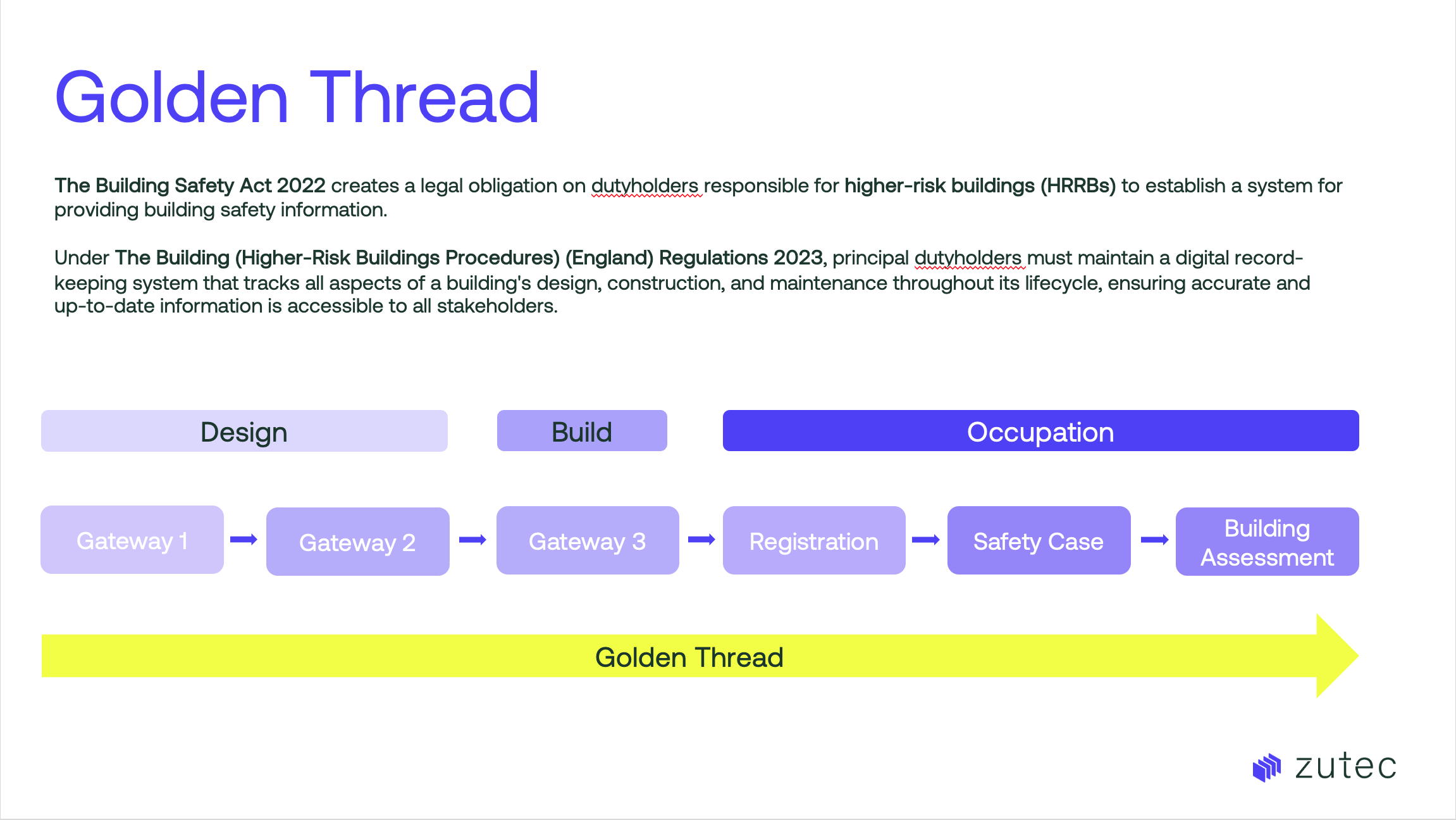
This golden thread must be kept electronically, ensuring it is accurate, up-to-date, and secure from unauthorised access. Additionally, it should be easily transferable to others so that information is easily findable and readable by the intended audience. The client must also do its utmost to ensure that the language, terminology, and definitions used in the golden thread are consistent.
This system ensures that accurate and up-to-date building information is readily accessible to all relevant stakeholders, including developers, architects, engineers, contractors, and building managers to make informed decisions.
What is the golden thread in construction?
A digital record-keeping system that tracks all aspects of a building's design, construction, and maintenance throughout its lifecycle, ensuring accurate and up-to-date information is accessible to all stakeholders.
By maintaining detailed records of building information, dutyholders responsible for higher-risk buildings (HRRBs) can demonstrate compliance with building regulations and effectively manage safety risks, such as fire hazards and structural issues.
This proactive approach aims to prevent incidents like the Grenfell Tower tragedy from happening again by ensuring that crucial safety information is always available on every HRRB and can be understood and acted upon promptly when required.
Its ultimate purpose is to make sure that anyone involved in the process of constructing and operating a building, including emergency services, has the information they need when they need it so that they can make decisions that help better control risk, and keep a building and its occupants safe.
Simple-to-use Golden Thread CDE for managing in-use HRRBs
Consolidate existing building information in one place, supporting your Higher-Risk Building property portfolio and safety case submission.
Is the golden thread a legal requirement?
The Building Safety Act and its accompanying regulations are statutory instruments laid out by the former Government’s Department for Levelling Up, Housing and Communities. They are legally binding regulations to ensure higher safety and standards in building construction and maintenance, particularly for buildings that pose greater risks due to their size and occupancy and aim to deliver improvements across the entire built environment.
To ensure the Act is overseen and obligations are fulfilled by the industry, the government has also set up a national regulator in England as part of the Health and Safety Executive. The newly formed Building Safety Regulator has been put in place to enforce the new safety standards. To learn more about the Building Safety Regulator and the new building safety regulatory framework, read our blog, ‘The Building Safety Regulator — navigating the new framework’.
The obligation to produce, maintain and store a golden thread information falls under The Building (Higher-Risk Buildings Procedures) (England) Regulations 2023 which governs the design and construction of higher-risk buildings, and works carried out to them.
The regulation mandates the following.
Building control approval applications
The client must apply for building control approval at Gateway 2. This new stop/go point requires submission to and approval by the Regulator before any work begins. The application must include details on meeting the new dutyholder competence, golden thread, and mandatory occurrence reporting requirements.
Change control
A change control procedure must be established for any changes to project management or construction compared to the approved building control application.
The procedure covers three types of changes: recorded, notifiable, and major. For multiple related changes, the procedure outlines the necessary steps. A recorded change is any change that is not notifiable or major and must be logged in the change control log before implementation.
The principal contractor is responsible for maintaining the log, which must include information demonstrating that the change has been considered and will comply with relevant building regulations.
Mandatory occurrence reporting
The regulation requires principal dutyholders to establish a mandatory occurrence reporting system before construction begins and maintain it throughout the project.
This system must enable prompt reporting of safety occurrences. All those working on a project or visiting a site must be informed on how to use the system. Once construction starts, the principal contractor and principal designer must inspect the building and design work for safety occurrences.
Handover of information on completion
The client responsible for a higher-risk building (HRB) must maintain a copy of specific "golden thread" information, including details on fire safety (part B), ventilation (part F), energy (part L), and overheating (part O) — collectively known as "BFLO information" — to the relevant person by the completion date of the work or before the building is occupied. The principal contractor must hand over this information to the client while maintaining its original filing structure and ensuring it is in a format that the relevant person can read, keep, and update.
Completion certificates
A completion certificate application must contain information about the “as built” building work, rather than how it was originally designed. The process for applying for a completion certificate, also known as Gateway 3, forms an integral part of the more rigorous regulatory process.
Under the Act, it is an offence for any new residential unit in a higher-risk building to be occupied without a completion certificate being issued first. Only when a completion certificate is obtained can the accountable person allow lawful occupation.
Who is responsible for maintaining the golden thread of information?
The golden thread involves two main components: documentation of building work, and operations and maintenance. This dual focus ensures that any modifications or enhancements to a building are meticulously recorded and managed, allowing for continuous monitoring and mitigation of potential risks.
The information must be available to regulatory bodies such as the BSR, Fire and Rescue Services, other building bodies and accountable persons (APs) for the building, as well as residents or owners of residential units in the building.
You must keep a digital record of information about a building if you are:
- A client, principal designer or principal contractor working on a project that involves a higher-risk building.
- An accountable person or principal accountable person responsible for a high-rise residential building.
Documentation of building work
Having golden thread information in one place during the design, planning and construction of a higher-risk building makes it easier for responsible parties to:
- Prepare the documents needed when applying for building control approval at Gateway 2.
- This must include drawings and plans, and Fire and Emergency (FEF) file, a change control log with an effective audit trail and more.
- Gather information and relevant safety and combined BFLO information to submit to the BSR when applying for a completion certificate and passing Gateway 3.
- This must include record and evidence of the design work during the construction phase and have a mechanism in place to deliver relevant fire safety information to the Responsible Person.
- Register Higher-Risk Residential Buildings and submit Key Building Information.
- This information must be provided to the BSR within 28 days of registration.
- Prepare building safety risk documents and structural safety details so they are readily available to build a Safety Case.
From occupation to maintenance
Having a central repository of digital and structured golden thread documentation when a building is occupied or could be occupied by residents makes it easier to:
- Apply for a Building Assessment Certificate and provide a Safety Case Report promptly to the BSR upon request to show how you will assess and manage building safety risks in your buildings, including the spread of fire and structural failure.
- Understand the fire safety strategy for the buildings you are responsible for.
- Prepare and update a resident engagement strategy to keep residents informed and consulted on any building safety decisions.
- Establish and operate a mandatory occurrence reporting (MOR) system.
Why the golden thread must be digital
Implementing the golden thread requires robust information management practices, including the use of digital tools to store and organise data.
Government guidance states that managing and storing a golden thread of information about a higher-risk building must be:
- Kept digitally
- Secure from unauthorised access
- Available when someone needs the information
- Presented in a way someone can use
- A building’s single source of truth
- Accessible, by providing the information in a simple format that is easy to understand and written in plain English
- Compliant with General Data Protection Regulation (GDPR)
This digital approach enhances accessibility and reliability so that when emergency responders or maintenance teams need to act, information is available. At the same time, the golden thread supports a culture of safety and accountability within the construction industry by providing a clear audit trail of decisions and actions taken throughout a building's life.
And as such, the golden thread in construction is a vital mechanism for safeguarding building integrity and occupant safety. By mandating comprehensive record-keeping and fostering a collaborative approach to information management, the golden thread aims to create safer, more resilient buildings for the future.
How to prepare for a golden thread of information
A golden thread of information demonstrates how a building complies with building regulations from conception to completion. This includes information on how those responsible for building work will comply with their duties, and how work will be completed so they build what they set out to build and aligns with the designs.
Client’s responsibilities
As a client, you will need to prepare information that describes the building and shows how it complies with building regulations, including:
- Drawings and plans
- Competence declaration
- Construction control plan
- Change control plan and log
- Building regulations compliance statement
- Fire and emergency file
- Client authorisation
- Site location plan
- Mandatory occurrence reporting plan
- Planning statement
- A partial completion strategy
Principal designer’s responsibilities
As the principal designer, you must capture and keep all the design information up to date by:
- Planning and managing the coordination of designs and building work to ensure (or to take all reasonable steps to ensure) that works carried out in accordance with designs will comply with relevant requirements.
- Submitting building designs for the building work to the client so that a building control approval application can be finalised.
Principal contractor’s responsibilities
As the principal contractor, you must use the record-keeping system provided by the client to ensure that information about the building is up to date by:
- Helping the client to provide information to anyone who needs it
- Working with the principal designer to share information relevant to the building work
- Having processes in place to help communication between all contractors
- Keeping evidence that the building work meets building regulations
- Working with the design team to manage control changes
Once a building is occupied, a digital record-keeping system must be managed to store information that supports the management of building safety risk.
Accountable persons’ and principal accountable persons’ responsibilities
As an accountable person or principal accountable person for a high-rise residential building, you must:
- Keep information about the building
- Manage the record-keeping system to store the information
How to achieve a golden thread
As a pioneer in digital O&Ms since the early 2000s, Zutec now offers a comprehensive set of digital solutions and modules for quality management, digital handover, and a common data environment (CDE), including a dedicated suite of golden thread solutions.
Our platform consolidates all building information and processes, enabling efficient management, document collation, actions, approvals, inspections, evidence collection, remediation, gateways, auditing, reporting, and compliance. This ensures a seamless golden thread of information throughout the building lifecycle.
When considering the best option for digital golden thread record-keeping solutions, it’s important that they meet the following requirements:
Accessibility and sharing
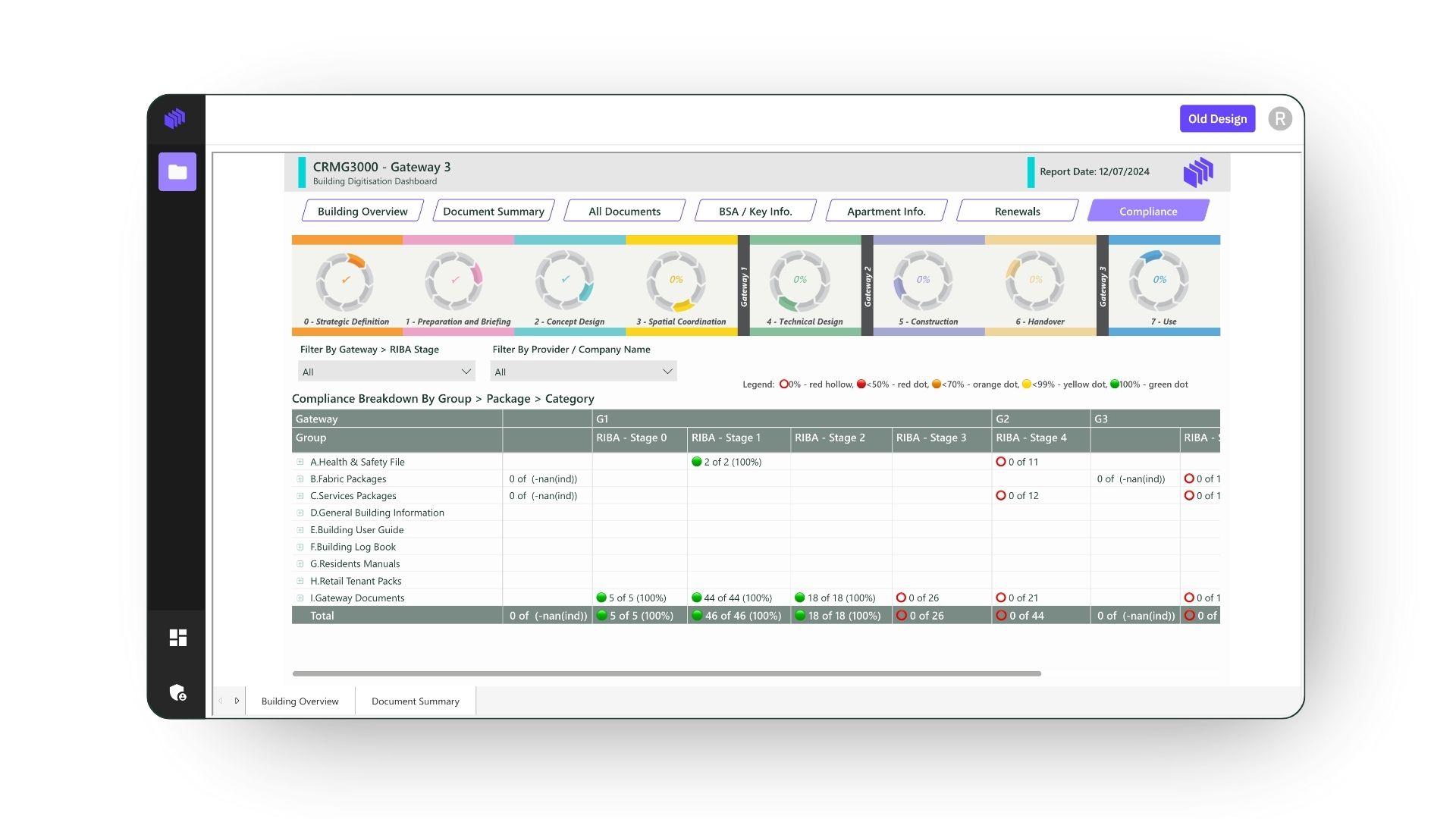
When building information is siloed electronically, offline, or even on paper, it can differ in quality and completeness, making it hard to find and even harder to understand if it demonstrates compliance. Additionally, where an existing building has become a HRRB, building information and asset data may be all over the place.
Zutec’s golden thread CDE centralises the storage of crucial building information vital for maintaining a digital golden thread so that the right people have the right information at the right time, whether you need it for a new or in-use building.
Analytics, auditability and information visibility

By having a centralised dashboard, maintaining safety and compliance throughout a building's lifecycle becomes more manageable. With Zutec stakeholders like building owners, managers, and maintenance teams gain a single dashboard to track and manage all their information. They can drive actions and tasks, make and review changes, and monitor when recertifications and inspections are due.
Additionally, with robust reporting and analytics, Zutec makes it easy to collate reports and track progress of projects, while providing a clear audit trail that gives visibility of all information. This auditability is crucial for demonstrating compliance with The Building Safety Act 2022 and for investigating any issues that arise.
Accuracy and up-to-date information
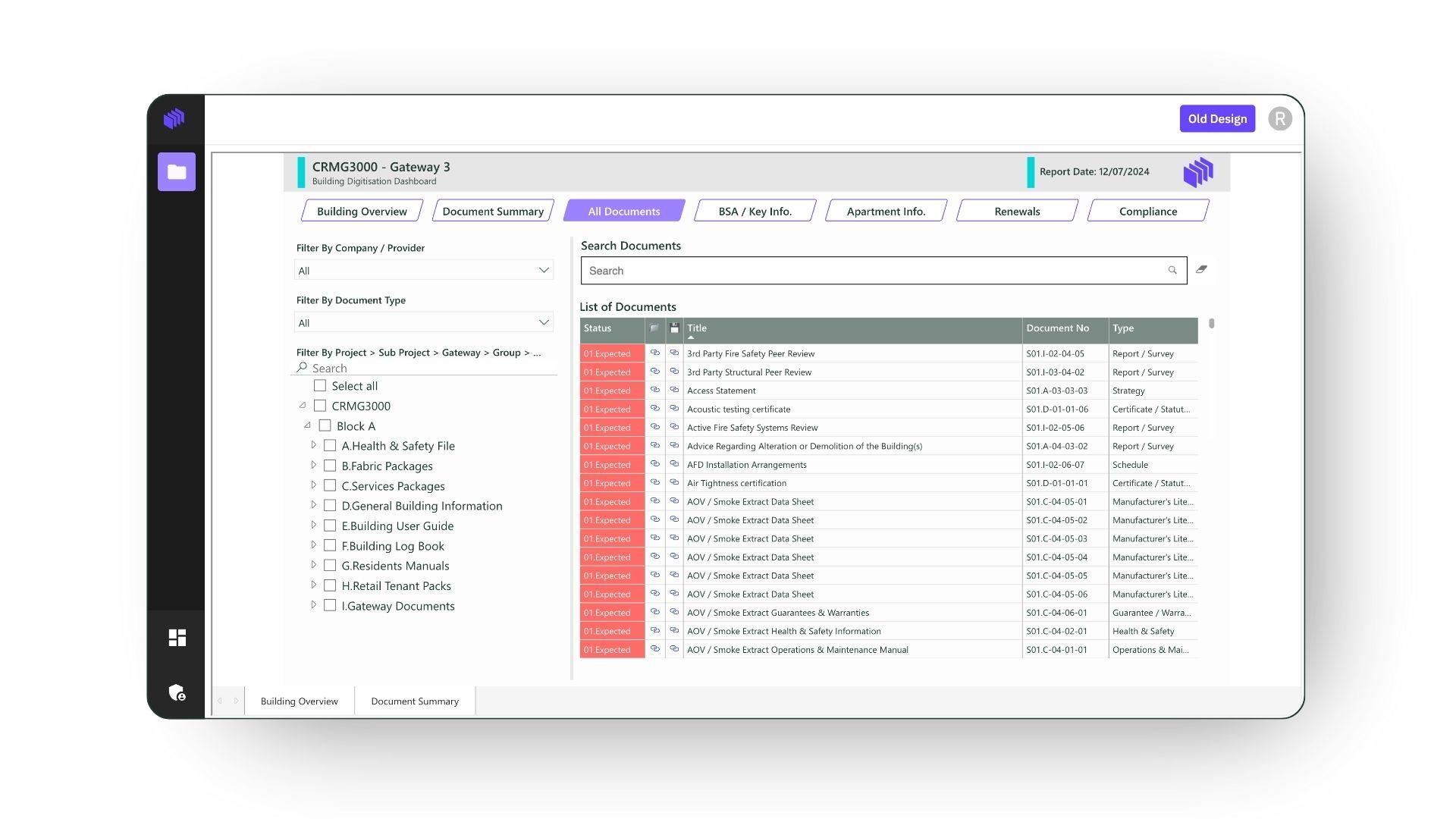
For an accurate golden thread, digital records such as drawings and plans, construction, change control plans, logs, fire and emergency files and Gateway documents can all be updated in real-time, ensuring that the information is always current, correct and there are no data gaps.
This is particularly important for managing building control approval, submitting Key Building Information, preparing Building Safety Case reports, and managing safety risks, as outdated or inaccurate information can lead to non-compliance and profound consequences.
Zutec’s unified data repository includes a defined data model, templates, and agreed deliverables, all of which can be governed by version control. This means information can be processed, retrieved, and relied upon more easily.
Efficiency and productivity
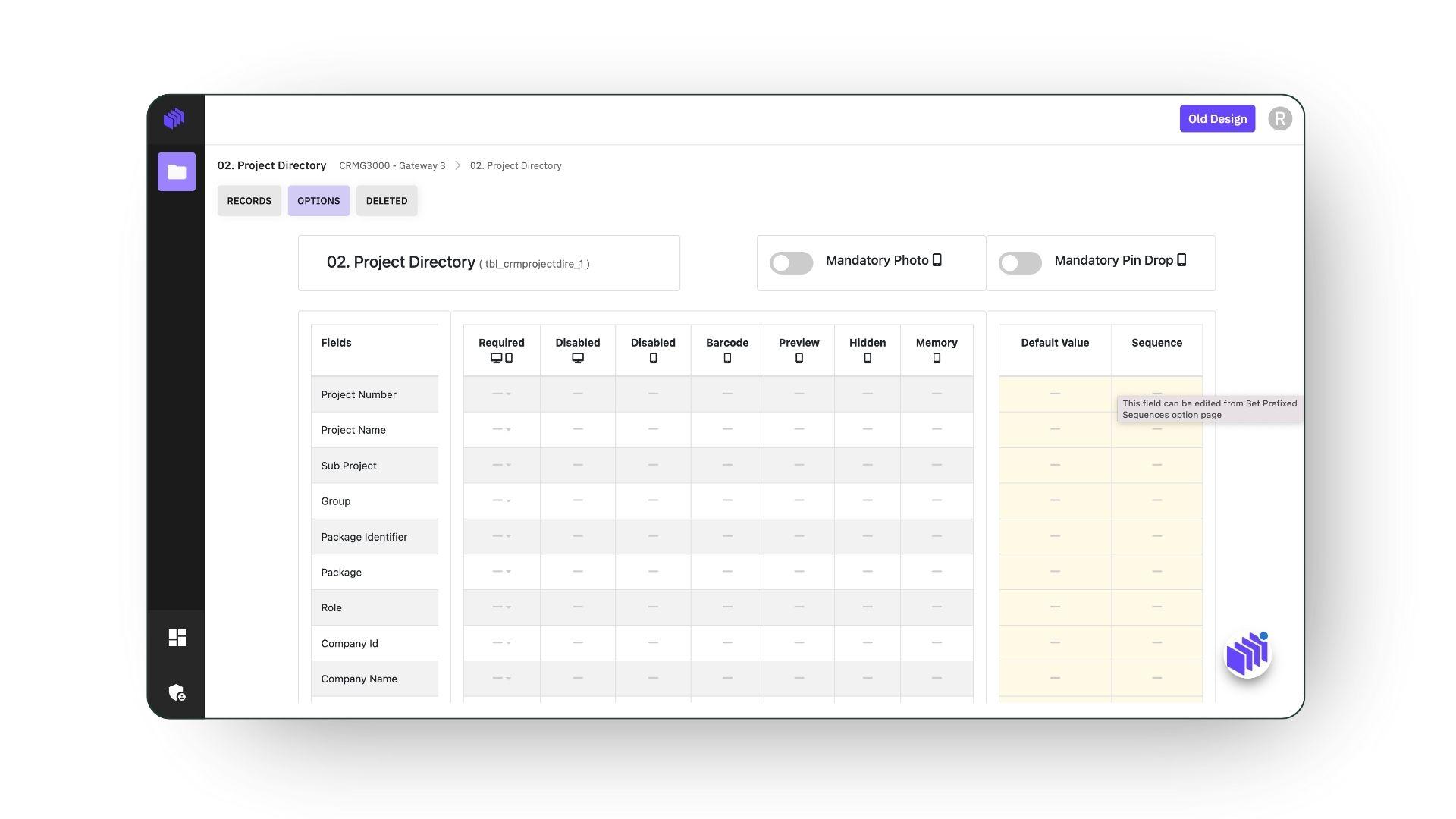
Digital systems should use structured data to map project attributes such as property name, unit number, package, RIBA (Royal Institute of British Architects) stage, company name, document type, and status to streamline the recording, storing, and retrieving information.
This efficiency reduces the time and effort required to collate and manage records, minimises errors associated with manual data entry, and enhances overall productivity.
Zutec’s structured digital forms and workflows, based on the attributes outlined above, ensure that information is captured accurately and consistently, further improving the quality and reliability of the data.
Security
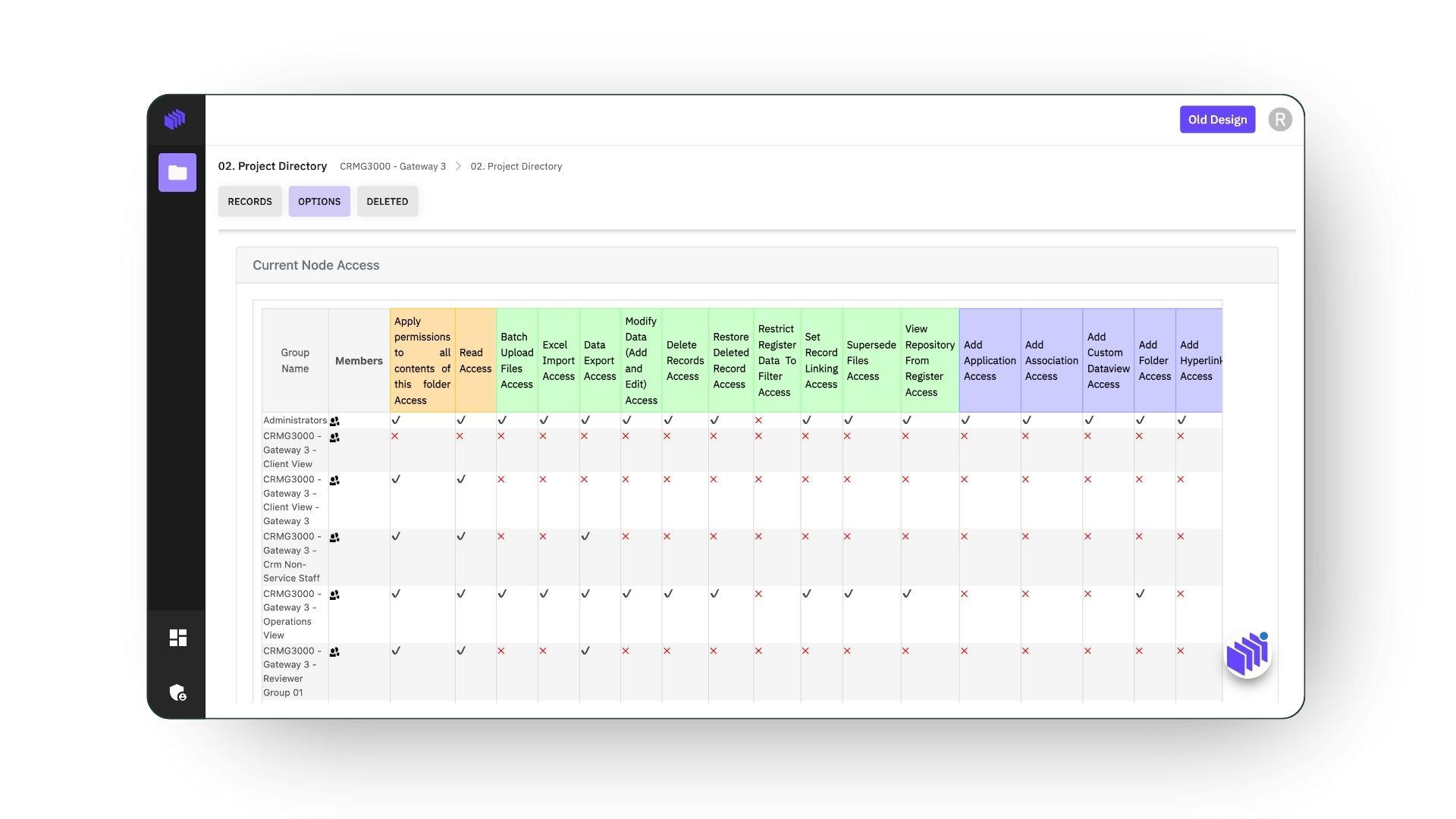
When storing sensitive building information, proper cybersecurity measures must be in place to protect data. Zutec is an ISO 27001-certified information security management system (ISMS) with backup and disaster recovery failover and, as such, protects against data loss, unauthorised access, and tampering.
Ensure comprehensive golden thread management
Getting the "golden thread" right is essential for maintaining comprehensive, accurate, and up-to-date records of a building's design, construction, and maintenance throughout its lifecycle which can be easily managed throughout a building's lifecycle.
To centralise and access all critical building information with robust reporting, analytics, and security, it's essential to choose the right tool for the job.
Start enhancing your golden thread management with Zutec’s Golden Thread CDE and contact our experts today.